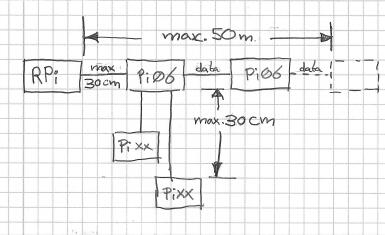Table of Contents
RocNetNode



![]()
![]()
![]() Content → Command Stations → RocNet
Content → Command Stations → RocNet
-
-
- GCA-Pi01 | Pi01Can | GCA-Pi02 | GCA-PI03 | GCA-PI04 | GCA-Pi05 | GCA-Pi06 | GCA-PI07 | GCA107 Relay board | RocDisplay | Fast Clock | LED driver Pi08
| RocNetNode is superseded by WIOpi, but is still maintained. |
|---|
RocNet system with Raspberry Pi microcomputers
Overview
The RocNetNode with its boards is a complete DIY Control System based on commonly used hardware standards.
It can be used for controlling:
- Mobile decoders; Trains.
- Switches, Multi aspect signals, FiddleYards, Turntables, Servos, Daylight…
- Feedback, Occupancy, Inputs…
Standards
- The well known I2C standard is used as bus between all GCA-Pi boards.
- A standard Ethernet LAN is used as connection between Rocrail and the RocNetNodes.
- The Open Source RocNet Protocol is used to communicate with Rocrail.
Boards
Raspberry Pi
The popular 'credit-card-sized' computer is used as base of the RocNetNode.
Supported Boards
- Raspberry Zero
- Raspberry Pi 1, 2 and 3
The Raspberry Pi 4 is currently not supported.
It can be used as software command station too, using DCC232 or SPROG.
“Raspberry Pi" is a trademark of the Raspberry Pi Foundation.
GCA-Pi06 5V Power Supply
5V 3A Power supply and patch panel. (Preferred over power adapters.)
GCA-Pi01 Interface
The interface between the Raspberry Pi and the I2C bus.
GCA-Pi02 32 I/O
32 programmable I/O ports with MACRO support for signal aspects.
It is compatible with all GCA interface boards.
The GCA-107 Multi purpose Relay board can be used for frog polarization.
GCA-Pi03 16 Servo
16 PWM ports for controlling servos, LEDs…
The GCA77 can be connected for max 24V 500 mA dc per port.
Even higher values in dc are possible with GCA76
Both buffer boards are each able of dimming 8 independent outputs.
GCA-Pi04 Throttle
A hand held throttle with 28 functions at hand.
GCA-PI07 Transformer Sensor
Zero loss current detection.
Due to some no longer available parts, this unit is no longer available, see GCA94 instead.
Ordering information
Cables
All boards are accepting RJ45 and/or RJ12 connectors.
The RJ45 connector can be used with CAT-5 patch cables.
The RJ12 compatible cables are commonly used by Digitrax LocoNet® and Lenz Xpressnet systems.
Max cable length
Configuration
A very comfortable Configuration utility is provided in Rocrail.
Updating a RocNetNode is done with just a single mouse click.
Features
- No firmware needed, just plain Linux-C and Rocrail libraries.
- RocNet UDP Multicast
- 128 I/O ports.
- Delayed off inputs for occupancy detectors.
- Pulse timed outputs with off event.
- Blink function for outputs.
- Loco and Function commands.
- POM
- Command Station support:
- Shutdown event on kill; Rocrail will power off and stop all trains.
- Send every second an identification message until it is acknowledged. This procedure is restarted after the host reported a shutdown.
- Start of Day support. After an identify acknowledge the current input status will be broadcasted.
- Sensor acknowledge; Ten times retry every 500ms.
- Save the output state on "global power off" for restoring them at restart of the RocNetNode.
- Nodes which identify itself with ID 65535 receive automatically an ID in the normal range: 2…65534.
- 128 macros with max. 8 commands each.
- One click software update.
- 128 PWM channels for servos, signals and lighting.
- Max. 11 minutes for 4096 steps. (steps=1, delay=15)
- RocMouse support.
- A RasPi/RocNetNode can be mounted in a large scale locomotive when using a USB-WiFi stick for reporting the RFID tags, controlling the decoder with a S-Nano and offers 128 I/O.
Addressing
The addressing is linear: FADA
Only the Bus(ID) and the Address(RasPi Port) fields are used.
Loco
- DCC232 / SPROG
- Bus → RocNetID (Or default Loco Bus.)
- Address → addrH + addrL
- Node (RasPi in G-Loco)
- Bus → 0
- Address → RocNetID
Accessories
Default
- Bus → RocNetID
- Address → Port (1…128)
DCC
- Bus → RocNetID
- Address → Address (FADA)
- Type → DCC, MM, …
Servos
- Bus → RocNetID
- Address → Port (1…128)
- Single gate
- Port type:
- Digital port: Switch or Accessory
- PWM channel: Servo
Sensors
- Bus → RocNetID
- Address → Port (Pi02: 1…128, Pi07: 129-160)
Signal Aspects
Signal aspect numbers are mapped to Macros:
- Bus → RocNetID
- Address-1 → Macro port offset
- Aspect → Macro number (1…32)
Output Macro Type
- Bus → RocNetID
- Address → Macro number (1…32)
- Parameter → Macro number (1…32) for the Off command in case set > 0
Output Light Type
- Bus → RocNetID
- Address → PWM Channel (1…128)
- Value → Brightness (0…255), this value will be multiplied by 16 in RocNetNode.
Output Color Light Type
- Bus → RocNetID
- Address → Not used
- Color channel RGBWW → PWM Channel (1…128); Both white channels are optional and can be set to zero to disable them.
- Value → Brightness (0…255), this value will be multiplied by 16 in RocNetNode.











